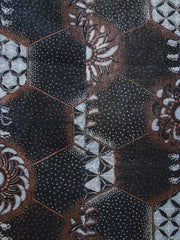A Length of Katazome: Two Joined Pieces and Unusual Pattern
late nineteenth century
21" x 12 1/2", 31.5 cm x 31.5 cm
Sometimes in the nineteenth century katazome or stencil resist dyed cloth was designed with such invention and daring that there appeared almost-strange patterns like this one. Please note that this fragment is hand stitched from two pieces with a seam running up its center.
The unusual design of the cloth is loosely arranged around the concept of a hexagon (a reference to tortoise shell which is a symbol for long life).
We see highly stylized chrysanthemums along with hexagons--each of the hexagons contain another motif: in the intact hexagons we see shippo tsunagi or interlocking circles; in the middle where the hexagons are sliced we see they contain triangles that can also be the fish scale motif.
The color tones are a very pale blue--it gives a glowing effect--a reddish tone based on iron oxide dye and a deep indigo.
The pattern is almost other-worldly both for its unusual design but also for the use of the few colors assigned to the parts of the pattern. The center join adds more quirkiness to an already very unusual design.
Recommended.


